Speyer
| Speyer | ||
|---|---|---|
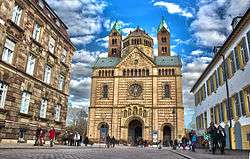 Speyer: Maximilianstraße with cathedral in the background | ||
| ||
 Speyer | ||
| Coordinates: 49°19′10″N 8°25′52″E / 49.31944°N 8.43111°ECoordinates: 49°19′10″N 8°25′52″E / 49.31944°N 8.43111°E | ||
| Country | Germany | |
| State | Rhineland-Palatinate | |
| District | Urban district | |
| Government | ||
| • Lord Mayor | Hansjörg Eger (CDU) | |
| Area | ||
| • Total | 42.58 km2 (16.44 sq mi) | |
| Elevation | 92 m (302 ft) | |
| Population (2017-12-31)[1] | ||
| • Total | 50,931 | |
| • Density | 1,200/km2 (3,100/sq mi) | |
| Time zone | CET/CEST (UTC+1/+2) | |
| Postal codes | 67346 | |
| Dialling codes | 06232 | |
| Vehicle registration | SP | |
| Website | www.speyer.de | |
Speyer (German pronunciation: [ˈʃpaɪ̯ɐ], older spelling Speier, known as Spire in French and formerly as Spires in English) is a town in Rhineland-Palatinate, Germany, with approximately 50,000 inhabitants. Located beside the river Rhine, Speyer is 25 km (16 miles) south of Ludwigshafen and Mannheim. Founded by the Romans, it is one of Germany's oldest cities. Speyer is dominated by the Speyer Cathedral, a number of churches and the Altpörtel (old gate). In the cathedral, beneath the high altar, are the tombs of eight Holy Roman emperors and German kings.
The city is famous for the 1529 Protestation at Speyer.
History
| Free Imperial City of Speyer Reichsstadt Speyer | |||||||||
|---|---|---|---|---|---|---|---|---|---|
| 1294–1792 | |||||||||
| Status | Free Imperial City of the Holy Roman Empire | ||||||||
| Capital | Speyer | ||||||||
| Common languages | Palatine German | ||||||||
| Government | Republic | ||||||||
| Historical era | Middle Ages | ||||||||
• Founded | ca 10 BC | ||||||||
• Gained Reichsfreiheit | 1294 | ||||||||
| 19 April 1529 | |||||||||
• Protestation at Speyer | 20 April 1529 | ||||||||
| 1688 | |||||||||
| 1792 | |||||||||
• Annexed to Bavaria | 1816 1792 | ||||||||
| 10 August 1946 | |||||||||
| |||||||||
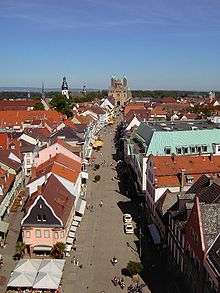
The first known names were Noviomagus and Civitas Nemetum, after the Teutonic tribe, Nemetes, settled in the area. The name Spira is first recorded in the 7th century, taken from villa Spira, a Frankish settlement situated outside of Civitas Nemetum.
Timeline
- In 10 BC, the first Roman military camp is established (situated between the town hall and the episcopal palace).
- In AD 150, the town appears as Noviomagus on the world map of the Greek geographer Ptolemy.
- In 346, a bishop for the town is mentioned for the first time.
- 4th century, Civitas Nemetum appears on the Peutinger Map.
- 5th century, Civitas Nemetum is destroyed.
- 7th century, the town is re-established, and named Spira after a nearby Frankish settlement.
- In 1030, emperor Conrad II starts the construction of Speyer Cathedral, today one of the UNESCO World Heritage Sites. Also in the 11th century, the first city wall was built.
- In 1076, emperor Henry IV embarks from Speyer, his favourite town, for Canossa.
- In 1084, establishment of the first Jewish community in Speyer.
- In 1096, as Count Emicho's Crusader army raged across the Rhineland slaughtering Jewish communities, Speyer's Bishop John, with the local leader Yekutiel ben Moses, managed to secure the community's members inside the episcopal palace and later lead them to even stronger fortifications outside the town. It was ruled that anyone harming a Jew would have his hands chopped off.[2]
- In 1294, the bishop loses most of his previous rights, and from now on Speyer is a Free Imperial Town of the Holy Roman Empire.
- In 1349, the Jewish community of Speyer is wiped out.
- Between 1527 and 1689, Speyer is the seat of the Imperial Chamber Court.[3]
- In 1526, at the Diet of Speyer (1526) interim toleration of Lutheran teaching and worship is decreed.
- In 1529, at the Diet of Speyer (1529) the Lutheran states of the empire protest against the anti-Reformation resolutions (19 April 1529 Protestation at Speyer, hence the term Protestantism).
- In 1635, Marshal of France Urbain de Maillé-Brézé, together with Jacques Nompar de Caumont, duc de La Force, conquers Heidelberg and Speyer at the head of the Army of Germany.
- In 1689, the town is heavily damaged by French troops.
- Between 1792 and 1814, Speyer is under French jurisdiction.
- In 1816, Speyer becomes the seat of administration of the Palatinate and of the government of the Rhine District of Bavaria (later called the Bavarian Palatinate), and remains so until the end of World War II.
- Between 1883 and 1904, the Memorial Church is built in remembrance of the Protestation of 1529.
- In 1947, the State Academy of Administrative Science is founded (later renamed German University of Administrative Sciences Speyer).
- In 1990, Speyer celebrates its 2000th anniversary.
Main sights
- Cathedral
- Altpörtel – Old town gate
- Gedächtniskirche – Memorial Church
- Jewish courtyard – Remnants of medieval Synagogue and intact mikve
- Technikmuseum Speyer – Transportation Museum
- Historical Museum of the Palatinate
Transportation
Speyer lies on the Schifferstadt-Wörth railway and offers hourly connections to Mannheim and Karlsruhe.
Mayors
Since 1923 the mayor was a Lord Mayor.[4]
|
Twin towns – sister cities
Notable natives
Born before 1900
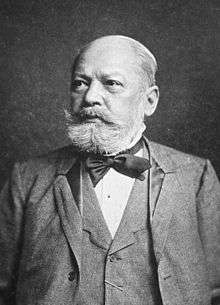
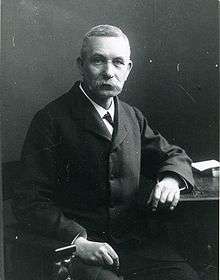
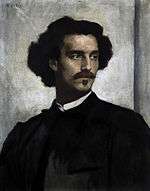
- Samuel of Speyer (after 1096-death unknown), Exeget of Torah and Midrash
- Judah ben Samuel of Regensburg (1140-1217), scribe and philosopher
- Julian of Speyer (before 1225- ~ 1250), medieval choir master, composer and poet from the Order of the Franciscans
- Gabriel Biel (~ 1415-1495), scholastic philosopher
- Dietrich Gresemund (1477-1512), author
- Egon VIII of Fürstenberg-Heiligenberg (1588-1635), Reichsgraf of Fürstenberg-Heiligenberg
- Johann Joachim Becher (1635-1682), German physician, alchemist, precursor of chemistry, scholar and adventurer
- Moritz Georg Weidmann (1658-1693), publisher and bookseller
- Adolf von Dalberg (1678-1737), Prince of Fulda
- Simha of Speyer (13th century) German rabbi and tosafist. He was one of the leading signatories of the Takkanot Shum.
- Philipp Hieronymus Brinckmann (1709-1760), landscape and historical painters as well as copper cutters
- Johann Martin Bernatz (1802-1878), landscape painter
- Anselm Feuerbach (1829–1880), German painter
- Carl Jakob Adolf Christian Gerhardt (1832–1902), German physician
- Henry Villard (1835–1900), German-American journalist
- Hermann von Stengel (1837-1919), Bavarian Administrative Officer
- Wilhelm Meyer (philologist) (1845-1917), classical philologist, mediavist and librarian
- Karl Heinrich Emil Becker (1879-1940), general of the artillery, ballist and defense scientist
- Hans Purrmann (1880-1966), painter, graphic artist, art writer and collector
- Hermann Detzner (1882-1970), leader of the German Schutztruppe in German New Guinea
- Karl-Adolf Hollidt (1891-1985), Army officer (Generaloberst) and war criminal
- George Waldbott (1898–1982), German-American physician
Born after 1900
- Jakob Brendel (1907-1964), wrestler
- Karl Haas (1913–2005), German-American music educator and radio presenter
- Helmut Bantz (1921-2004), gymnast
- Alfred Cahn (1922-2016), German musician and composer
- Edgar E. Stern (born 1926), clinical social worker and author of The Peppermint Train: Journey to a German-Jewish Childhood
- Gabriel Kney (born 1929), Canadian organ builder
- Jürgen Brecht (born 1940), fencer
- Gerhard Vollmer (born 1943), physicist and philosopher
- Jürgen Creutzmann (born 1945), politician ( FDP)
- Hans-Joachim Lang (born 1951), journalist, Germanist, historian and honorary professor
- Axel Schimpf (born 1952), Vice Admiral of the German Navy
- Eberhard Bosslet (born 1953), artist
- Kay Friedmann (born 1963), footballer
- Markus Kranz (born 1969), football player
- Christoph Bechmann (born 1971), German field-hockey player
- Anke Vondung (born 1972), opera singer
- Ralf Schmitt (born 1977), football player
- Simone Weiler (born 1978), swimmer
- Jochen Kühner (born 1980), rower
- Martin Kühner (born 1980), rower
- Matthias Langkamp (born 1984), football player
- Christian Reif (born 1984), long jumper
- David McCray (born 1986), basketball player
- Florian Krebs (born 1988), football player
- Sebastian Langkamp (born 1988), footballer
- Jonas Marz (born 1989), footballer
- Gianluca Korte (born 1990), footballer
- Raffael Korte (born 1990), footballer
- Lars Stindl (born 1988), German footballer
- Elias Harris (born 1989), German international basketball player
See also
Notes
- ↑ Statistisches Landesamt Rheinland-Pfalz "Bevölkerungsstand 2017 - Gemeindeebene" Check
|url=value (help). Statistisches Landesamt Rheinland-Pfalz (in German). 2018. - ↑ Simon Schama, The History of the Jews, Vintage Books 2014 p.298
- ↑

- ↑ Der Kaiserdom zu Speyer – Startseite
- ↑ "Städtepartnerschaften" (official web site) (in German). Stadt Speyer. Retrieved 2015-01-16.
- ↑ "International collaboration". gmiezno.eu. Gniezno. Retrieved 3 May 2014.
- ↑ "Ningde (China)" (official web site) (in German). Stadt Speyer. Retrieved 2015-01-16.
External links
| Wikimedia Commons has media related to Speyer. |
| Wikivoyage has a travel guide for Speyer. |
- speyer.de the town website (partly in English)
- museum.speyer.de Historical Museum of the Palatinate (in English)
- dom-speyer.de website of Speyer Cathedral (in German)
- Model Map of Medieval Speyer
- Speyer, its cathedral and the library of its chapter
- Technical (Transport) Museum
- www.speyer.de: living history in past times
- www.speyer-tour.de: Guided tours through Speyer
- City overview and photos
